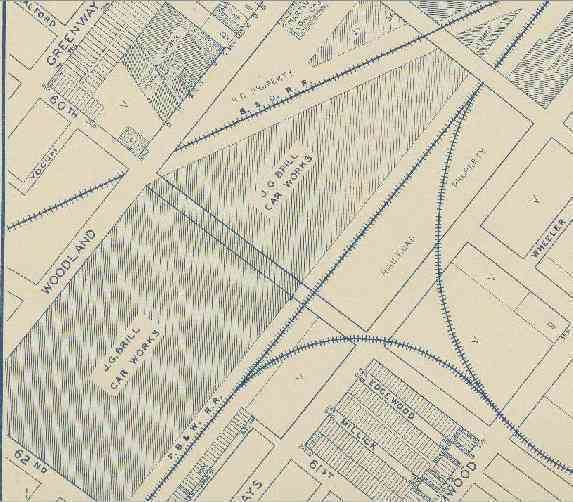Former type Privately held company Genre public transport Founded 1868 | Industry rail transport Founder John George Brill Defunct 1954 | |
 | ||
Products Streetcars (trams), interurban railcars, motor buses, and trolleybuses Headquarters Philadelphia, Pennsylvania, United States | ||
The J. G. Brill Company manufactured streetcars, interurban coaches, and buses in the United States for almost ninety years. The company was founded by John George Brill in 1868 as a horsecar manufacturing firm in Philadelphia. Over the years, it absorbed numerous other trolley-interurban manufacturers such as Kuhlman in Cleveland and Jewett in Indiana. With business diminishing, in 1944 it merged with the American Car and Foundry Company (ACF) to become ACF-Brill. It ceased trolley and bus production in 1954, though some of their interurbans served the Philadelphia area till the 1980s. Brill was the longest lasting of the nation's trolley and interurban manufacturers. It manufactured over 45,000 streetcars, trams (also known as trolleys or trolley cars in the U.S.), motor buses, trolleybuses and railroad cars. At its height, it was the largest manufacturer of streetcars and interurbans in the U.S. and produced more streetcars and interurbans and gas electrics than any other manufacturer.
Contents
History
J. G. Brill began operations in 1868. In 1926, ACF Motors Company obtained a controlling interest in Brill, and in 1944 the two companies merged, forming the ACF-Brill Motors Company. ACF-Brill announced in 1944 that Canadian Car and Foundry of Montreal, Quebec were licensed to manufacture and sell throughout Canada motor buses and trolley coaches of their design as Canadian Car-Brill. The firm built about 1,100 trolley buses and a few thousand buses under the name.
On January 31, 1946, a controlling interest in ACF-Brill was acquired by Consolidated Vultee Aircraft Corporation for $7.5 million. Consolidated Vultee was sold on November 6, 1947, to the Nashville Corporation, which sold its share to investment firm Allen & Co., headed by Charles Allen, Jr., on June 11, 1951. In early 1954, the Brill name disappeared when ACF-Brill ceased production and subcontracted remaining orders.
Products
The unique Bullet cars
The lines that operated interurban passenger cars recognized in the mid-1920s that they needed to build faster, quieter, more power efficient equipment. Up to that time, both the wood and most of the steel interurban cars were large, sat high, and were heavy. Streetcars were slow, noisy, and clumsy to operate using the motor controller "stand" of the time. Car manufacturers such as Cincinnati Car Co. (who already in 1922 made a lightweight, albeit slow, interurban), St. Louis Car Co., Pullman, and Brill worked to design equipment for a better ride at extremely high speed, improved passenger comfort, and reduced power consumption. This particularly involved designing low-level trucks (bogies) able to handle rough track at speed. Brill, in conjunction with Westinghouse and General Electric, worked on a new interurban design and on a new streetcar design. (The PCC). The interurban design result was the aluminum and steel wind tunnel (the first in the railway industry) developed slope roof "Bullet" MU cars, the first of which were purchased in 1931 by the Philadelphia and Western Railroad, a third rail line running from 69th Street Upper Darby to Norristown in the Philadelphia region.[4] This line still runs as SEPTA's Norristown High Speed Line. The Bullets could attain speeds as high as 92 mph (148 km/h). They were very successful and operated until the 1980s, but Brill sold few others. Only the central New York state interurban Fonda, Johnstown, and Gloversville Railroad which terminated at Schenectedy ordered Bullets, albeit a single-ended, single-unit "trolley-ized" version. Five were procured in mid-Depression 1932 for passenger business that was rapidly declining. In 1936, the closing FJ&G sold these Bullets to the Bamberger Railroad in Utah, which ran them in high-speed service between Salt Lake City and Ogden until the mid-1950s.[2] Three of the SEPTA Bullet cars are now at the Seashore Trolley Museum, one is at the Electric City Trolley Museum in Scranton, one is at the Rockhill Trolley Museum in Orbisonia PA, one is at the National Museum of Transportation in St. Louis MO, and one is at the Pennsylvania Trolley Museum in E. Washington. A Bamberger Bullet is in the Orange Empire Railroad Museum in Perris, Southern California, and another one has been preserved by the Utah State Railroad Museum; a third is a part of a restaurant building in Springville, Utah, but is barely recognizable as a Bullet.
Clients
Companies
The American Car & Foundry Co. controlled, as of January 26, 1926:
- American Car & Foundry Motors Co: owned Hall-Scott Motor Car Co (owned 100%) and Fageol Motors (Ohio) (controlled 90%)
- The J. G Brill Company, 62nd and Woodland Streets, Philadelphia. Absorbed and owned American Car Co. (not American Car and Foundry), Kuhlman Car Co. of Cleveland, Wason Manufacturing Company of Springfield, MA., Stephenson Car Co. of Elizabeth, NJ, Hall-Scott of San Francisco. In Europe, Cie. J. G. Brill of Gallardon, France, which was sold to Electroforge in 1935.
Other companies that built licensed versions of Brill vehicles:
Canadian railway car builder Preston Car Company was acquired in 1921 and operations were closed in 1923.
